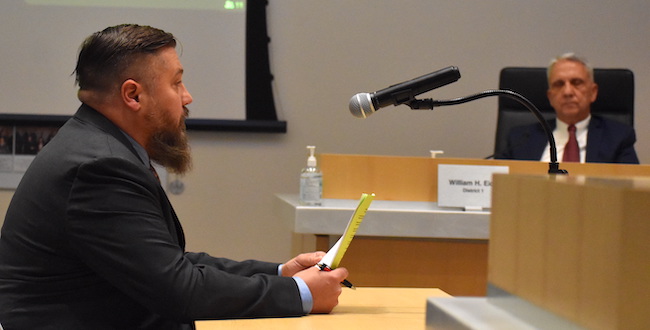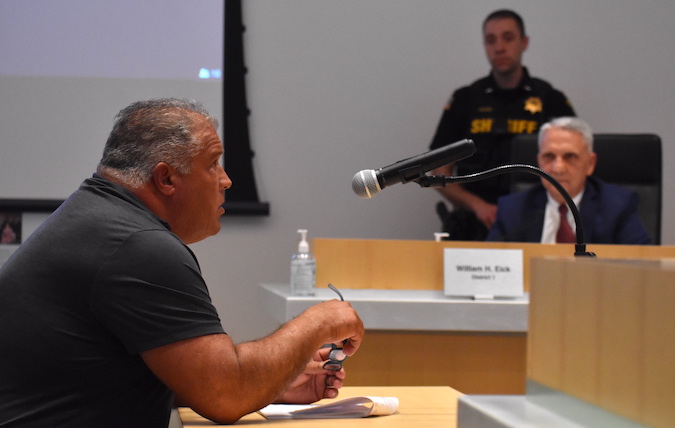At public hearing, speakers say District Court brings unknown expense, loss of local control
ALBION – District Attorney Joe Cardone sees a full-time district court as a much more efficient court system for Orleans County rather than the part-time town courts with varying office hours and court times.
Cardone has been trying for several years to bring district court to a public referendum in the county. That vote could happen in November.
First there will be two public hearings and then the County Legislature may decide to put the issue to a public vote.
The first hearing was Tuesday, and the next is 7 p.m. on June 4 in the legislative chambers of the County Office Building.
The proposal faced criticism during Tuesday’s hearing, with speakers saying the current system is serving the people well, and a district court brings “big government” and could result in more local expense.
“We have something here that works,” said Debbie Berry, a retired chief clerk for the Surrogate Court in Orleans County. “We’re not hearing any numbers. The people want to know what it costs.”

Paul Lauricella, chairman of the Orleans County Conservative Party, sees a district court as an expansion of government.
Cardone said the district court would ultimately operate at a much lower local cost because the state, by its own statue, pays the salaries of the staff and the security. The county would provide a building and its maintenance, Cardone said.
“There is no guarantee the state would pick up the costs of judges and clerks,” said Richard DeCarlo, a former Barre town justice. “We’re assuming they will do it.”
DeCarlo was a member of the 11-member district court committee, but he voted against the committee’s recommendations in its report. The county hasn’t said where the court would be located, DeCarlo said.
He sees a big expense in housing the court, whether it’s a major renovation to the Public Safety Building or the former GCC campus in Albion that has been acquired by the county.
“If we renovate the Public Safety Building, it’s seven figures,” DeCarlo said. “If we build new, it’s tens of millions of dollars.”
Virginia Nicholson, a former court staffer for retired Judge James Punch, commended Cardone and the committee for their work trying to bring the issue to the public. But Nicholson believes the community needs more information about potential staffing, court location and expense.
Tim McMurray, an Albion village trustee, said Cardone and other supporters of the district court have said the county should move to a district court partly because the state is likely to impose such a court in the near future.
Right now there are only district courts in Nassau and Suffolk counties. They were formed in the 1960s and no other counties have gone to that model.
McMurray said he has found nothing to suggest the state wants counties to move from town courts and replace them with district courts.
“It is not on the radar that another county is doing this,” McMurray said during the hearing.
Paul Lauricella of Yates, chairman of the Orleans County Conservative Party, said he prefers the current system where the town justices know their communities well.
“I’m concerned this in an expansion of government,” Lauricella said. “Once that ball gets moving there’s no stopping it.”

Kenneth “Ohi” Johnsen is president of the NYS Magistrates Association and the town justice in in the Town of Day in Saratoga County. The Magistrates Association, which includes 2,300 town and village justices in the state, opposes the district court. Johnsen said the local justices are well-trained and in touch with their communities.
Kenneth “Ohi” Johnsen, president of the NYS Magistrates Association, pushed back on statements from Cardone that judges who are attorneys have a better understanding of complex laws and dispense better justice.
Johnsen, a town justice in Saratoga County, said the village and town justices all do a minimum of 12 hours of judicial education each year and they have access to a hotline through the Office of Court Administration if they need any advice on complicated cases or issues.
One local resident, Ken Ortiz of Medina, spoke during the hearing and he said the local criminal justice system has made mistakes in cases brought against him that were eventually dismissed. He also said the justice system failed in the death of Theresa Karlak, who was hit by a car in Gaines while on a walk with her sister on Jan. 1, 2022.
Sherry R. Davenport, a past president of the NYS Magistrates Association, said the group opposes district courts because they aren’t as accessible as the local town and village courts. The local courts are close by with judges elected by their local residents, she said.
Davenport of Cortland said the local County legislature shouldn’t be pushing for a district court that would ultimately result in fewer local town justices. She said the Legislature shouldn’t be “running roughshod” over the local judicial branch.
She also noted of the 11 members on the district court committee, five did not vote in favor of it – 3 opposed the recommendations and 2 abstained.
Davenport said the committee’s report lacks solid facts on moving to a district court, and instead relies on anecdotes about shortcomings in local courts from the New York State Bar Association.
The Orleans County Magistrates Association has been steadfastly opposed to a district court. The town justices and court clerks at the town level have all signed a resolution last October saying they are against a district court in Orleans County.
Cardone served as co-chairman of the district court committee with Joanne Best, the county’s public defender.
Cardone noted the towns and villages have gone from 24 local justices about 20 years ago to the current 11. Albion and Medina both have abolished their village courts during that time and most towns are down to one justice. He said the local communities have shown they can make changes in their courts. That is partly why he believes Orleans can be a leader in reimagining how to run a local court system.

(Left) Former Gaines Town Justice Bruce Schmidt said he favors the district court as a better way to dispense justice. (Right) Ginny Nicholson said more information is needed on the proposal.
Cardone said the district court would be staffed full-time and offer more consistent justice throughout the county. He sees a district court as far more efficient than 10 town justice courts that typically operate part-time with staff available on a limited basis. They can make it difficult for people to get in contact with the court.
The committee is projecting the costs of the district court at $1.2 million with revenue at $175,000 in fines and forfeitures, and $110,000 through the traffic diversion cases for $285,000 total.
The expenses includes salaries for two judges at $320,000, clerk costs at $150,000, security at $150,000, a stenographer at $50,000, office supplies at $4,000, equipment at $2,500 and interpreter at $2,500.
Employee benefits – Social Security, Medicare, disability, retirement, workers’ comp, unemployment insurance and health insurance – would be an estimated $531,661. Facility costs would cost an estimated $50,000 a year.
The court would operate at a loss of $975,661, with the state picking up the expense, according to the report.
The 10 towns courts operate at an aggregate deficit of $462,160 (which doesn’t include the costs of employee benefits and facility expense), the report states.
The CAP court that does arraignments in mornings and evenings at the county jail, plus on weekends, is another $113,800. If there was a district court, the CAP court functions would shift to the district court.
Employee benefits and facility costs represent 57 percent of the costs of running a district court. If that same percentage is applied to the 10 town courts, that total “real cost” of those courts would be $1,001,935, plus the CAP court costs of $113,800, the report states.
“The citizens of Orleans County are paying approximately $1.1 million annually for a fragmented system of part-time courts consisting of lay judges,” the report states.









































































